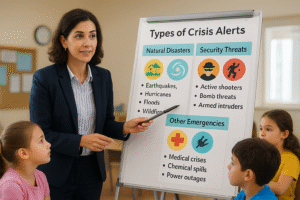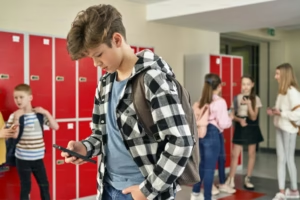Resources

School Security: Building Safer Campuses Through Awareness, Technology, and Readiness
Introduction
In today’s world, school security is no longer just about locked doors and morning drills.
It’s about creating a culture of awareness, communication, and preparedness that empowers every adult on campus to act quickly, confidently, and collaboratively when it matters most.
From kindergarten classrooms to large high school campuses, schools face an evolving range of challenges — from external threats to internal emergencies, from cyber safety to mental health concerns. Each one demands a coordinated, proactive approach to keeping students and staff safe.
In this article, we’ll explore the key pillars of modern school security, the role of technology in prevention and response, and how leadership can turn security from a checklist into a culture.
Understanding the Modern Definition of School Security
When most people think of school security, they imagine physical safety — fences, guards, or surveillance cameras. But in recent years, security has expanded into something broader and smarter.
Modern school security means:
- A combination of prevention, communication, and response.
- Integrating people, policy, and technology into one system.
- Creating a culture where every staff member knows their role in an emergency.
It’s no longer enough to rely solely on security hardware or annual drills. Today’s safest schools are those that build readiness into everyday routines, ensuring everyone on campus can recognize risks and act without hesitation.
The Growing Challenges Schools Face
Every school is unique, but their challenges often share common roots — limited resources, communication gaps, and time delays during crises.
Here are some of the top security challenges schools face in 2025:
Communication Breakdowns
When emergencies happen, confusion spreads faster than information.
Staff might rely on intercoms, emails, or phone chains — but those systems fail under pressure. Inconsistent or delayed messages can cause panic, misinformation, and unsafe responses. The Michigan School Crisis Communication Toolkit outlines how standardized emergency language and layered communication plans can reduce confusion
Human Error
Even the most trained staff can freeze in stressful moments. Without clear protocols or visual guidance, they may not know what to do or whom to contact. The Standard Response Protocol from NYSED helps schools define clear roles and actions during emergencies
Outdated Infrastructure
Many schools still depend on legacy security tools — cameras without AI, radios with poor range, or alert systems that can’t connect to law enforcement. CISA’s PACE Plan encourages layered, interoperable systems to modernize emergency communication
Increasing Mental Health and Behavioral Risks
Security isn’t only about external threats. Schools must now manage issues like student anxiety, bullying, and behavioral escalations with the same level of preparedness. The CDC’s Mental Health Action Guide offers proven strategies for promoting well-being and readiness in K–12 settings
Public Pressure and Compliance
Parents and communities expect transparency, fast communication, and clear action plans. New laws, like Alyssa’s Law in the U.S., require schools to have panic alert systems integrated with law enforcement.
The Role of Technology in Strengthening School Security
Technology has completely transformed how schools approach security. It’s no longer reactive — it’s predictive, preventative, and proactive.
Here’s how technology is reshaping safety:
Real-Time Alerts and Mass Notification Systems
A modern school alert system ensures that everyone — teachers, administrators, and responders — is notified instantly during an emergency.
These systems use multi-channel communication, including mobile devices, intercoms, digital displays, and wearables, ensuring no one misses the message.
Instead of hearing a vague announcement, staff receive clear, color-coded alerts like:
🔴 Lockdown: Security threat detected, secure classrooms.
🔵 Medical Emergency: Immediate medical help needed.
🟡 Admin Assist: Non-emergency assistance required.
🟢 All Clear: Situation resolved, resume normal operations or start of reunification.
This level of clarity removes guesswork, reduces panic, and enables quick, coordinated responses.
Integration With Law Enforcement and Emergency Services
Modern security systems can now connect directly with 911 dispatch centers and local police, ensuring faster external response times.
This compliance with mandates like Alyssa’s Law allows first responders to receive accurate, real-time data — reducing confusion and saving time.
Video Surveillance With AI Intelligence
AI-powered cameras now do more than record footage. They can detect unusual movement, crowd buildup, or restricted-area entry. Some systems can even alert administrators in real time if they detect aggression or suspicious behavior, allowing intervention before an incident escalates.
When integrated with communication platforms like SimulAlert®, this creates a fully connected security ecosystem where every device and person is part of a unified response network.
Access Control and Smart Entry Systems
Schools today are moving away from open-door policies. Smart access systems use ID badges, facial recognition, or RFID cards to control entry and monitor attendance. Research from the University of Michigan’s STPP program highlights how facial recognition in schools is being used to automate attendance and enhance campus security. This ensures that only authorized personnel and visitors can enter sensitive areas — keeping campuses more secure without feeling restrictive.
Data Analytics and Reporting
One of the most underrated aspects of modern school security is data. Every alert, drill, or incident generates valuable insights about response times, communication gaps, and staff readiness.
By analyzing these trends, schools can identify weaknesses and continuously improve their safety plans.
Building a Culture of Readiness
No system, no matter how advanced, can guarantee safety without a culture of readiness behind it.
This means empowering every teacher, administrator, and support staff member to feel confident and prepared during emergencies. Here’s how schools can foster that culture:
A) Leadership Commitment
School leaders set the tone. When superintendents and principals make security a visible priority, staff take it seriously.
Leaders should communicate openly about safety plans, invest in regular training, and encourage reporting of concerns without fear.
B) Staff Empowerment
Every adult in the school should feel equipped to take immediate action. That starts with training — not just once a year, but through ongoing refreshers, simulations, and discussions.
For example, color-coded alert systems make it easy for any staff member to trigger a response without needing to memorize complex codes or chains of command.
C) Consistent Drills and Evaluation
Drills are important, but they should focus on realism and reflection — not repetition. After each drill, schools should analyze what worked, what didn’t, and how communication could be improved.
The U.S. Department of Education’s REMS TA Center offers training modules and resources for emergency preparedness in schools.
D) Collaboration with Local Authorities
A strong relationship with local law enforcement and emergency responders can drastically improve response time and coordination. Inviting them to participate in drills builds familiarity and confidence on both sides.
The U.S. Department of Justice’s guide to school–law enforcement partnerships offers practical frameworks for building these relationships.
E) Communication With Parents and Students
Transparency builds trust. Parents should know the basics of the school’s security plan, how they’ll be notified during incidents, and how they can help reinforce safety culture at home.
Students, on the other hand, should be guided with reassurance — understanding safety without fostering fear.
The Safe Schools/Healthy Students (SS/HS) Framework emphasizes the importance of family and community involvement in school safety planning.
The Role of Superintendents and Administrators
Superintendents, Head of School, principals, and school administrators are at the heart of building security systems that work — both operationally and culturally.
Their role involves:
- Setting vision and policy – Security starts with leadership priorities.
- Budget allocation – Investing in technology that delivers real readiness.
- Communication – Keeping staff informed, trained, and aligned.
- Partnerships – Collaborating with vendors, local police, and emergency services.
Administrators who model calm, proactive leadership during both drills and real situations build trust among staff and students alike.
The Psychology Behind School Security
One often overlooked part of school safety is psychological readiness — how people behave under stress.
Studies show that when communication is clear, and roles are defined, individuals are less likely to panic and more likely to act logically.
That’s why modern safety systems focus not just on alerts, but on reducing mental load — replacing confusion with color, action with clarity, and chaos with control.
A teacher shouldn’t have to remember what “Code Red” means or count the number of button presses under pressure. They should simply see Red — and know exactly what to do.
The National Center on Safe Supportive Learning Environments offers tools for building clear, supportive protocols that reduce stress and improve emergency response
The Future of School Security
The next generation of school security is about integration and intelligence.
Here’s what the near future looks like:
- AI predicting potential risks based on behavioral patterns.
- Seamless coordination between schools and local emergency networks.
- Mobile apps empowering staff to report issues instantly.
- Smart badges serving both as access tools and communication devices.
- Cloud-based platforms like SimulAlert connecting every layer of safety — from alerts to analytics.
As technology evolves, so must our mindset: safety isn’t a one-time project; it’s a living system that grows with the community it protects.
Final Thoughts: Security is Everyone’s Responsibility
No matter how advanced a system is, true safety comes from collective responsibility. Every teacher, student, and staff member plays a part in maintaining vigilance and readiness.
When schools combine the power of technology with human awareness and trust, they create environments where security is felt — not forced.
That’s the real measure of a safe school.
Join the Conversation: Webinar Invitation
If your school is working to strengthen safety and communication, we’d love to have you join our upcoming free webinar:
Topic: Building a Culture of Readiness in Schools
Date: November 4th, 2025
Time: 2:00 PM EST / 11:00 AM PST
Speakers: Chad Gee (Superintendent, Kennedale ISD) and Greg Schwab (Assistant Superintendent, Edmonds School District)
You’ll learn how school leaders are transforming their campuses through proactive communication, and readiness training.
Register for the Webinar Here
Let’s move from awareness to action — and build schools where everyone feels safe, informed, and ready.



